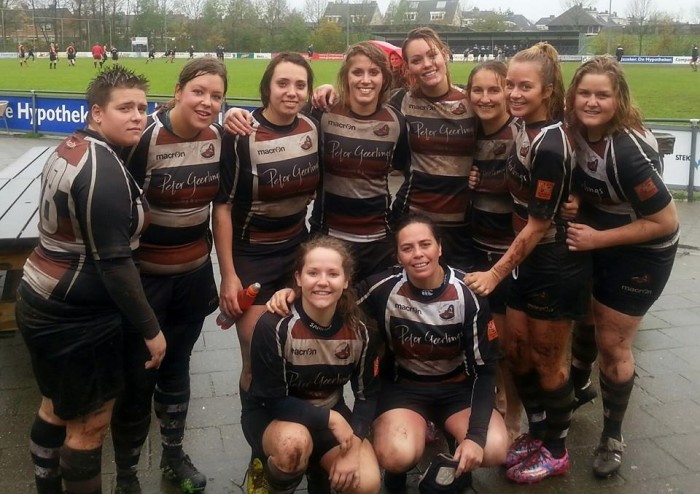European round-up
With the French Top 8 having a weekend off last week to allow players to prepare for Dubai, we thought we might take a look at club rugby around the rest of the continent. Although Scandinavian and Swiss rugby is on a winter break, fifteens leagues are thriving over much of western Europe.
Published by John Birch, November 28th, 2014
6 minute read

RC the Bassets celebrate qualifying for the final stages of the Dutch league
Netherlands
Despite sevens being the headline form of the game in the Netherlands, at club level fifteens remains the main format. Last weekend was decisive for many teams in the Honours Division of the Dutch league (Ereklasse). The day’s results determined who the top five clubs would be – RUS (champions for the past three years), AAC (the hosts of the Amsterdam Sevens), RC the Bassets (with Kelly van Harskamp now back playing XVs), URC, and SRC Thor - much the same as last season.
The leading clubs in Ereklasse have always been significantly stronger than those in the league below - it is not unusual for freshly promoted teams lose games by over 100 points. As a result this season the Ereklasse was split up into two pools of four, with the five teams from the two pools competing for the championship in the second half of the season – hence the importance of last weekend. The aim is that teams will play more matches against opposition on a similar level, with the top clubs facing challenges on a more regular basis.
Pool A was considered the toughest amongst the two pools; including RUS (Utrecht), RC the Bassets (Sassenheim), SRC Thor (Delft), and the Ma.R.Grieten (Maastricht), while Pool B included AAC (Amsterdam), URC (Utrecht), RC Tilburg, and Diok (Leiden).
The newly promoted teams, Diok and Ma.R.Grieten, had a predictably tough games with some big defeats. Tilburg has also been struggled, despite reaching the national final two years ago. The team has been ridden by injuries, and some of their players retired or have gone abroad. Sothey will continue their season in the relegation/promotional pool, together with NSRV Obelix (Nijmegen) and RC Delft – the best two teams from the lower division.
The second part of the competition will start after Sinterklaas (5thDecember).
Spain
There are some similarities between the Dutch and Spanish club seasons. In Spain the first half of the season is based around the 14 regional leagues of various sizes, the largest being those in Catalonia and Madrid.
In the Catalonian league GEIEG and INEF Barcelona, who between them provide a quarter of the Spanish squad, meet for the second leg of their championship playoff this weekend with INEF (home to such players as Laura Esbri and Angela del Pan) taking a 17-12 lead into the game against defending champions GEIEG (who include Elizabet Martinez and Julia Pla).
Meanwhile in Madrid Maria Casado’s Majadahonda look certain to lift that title ahead of Irene Schiavon’s Olympic this weekend as the need only to beat bottom team Aguilas de Toledo.
Madrid and Catalonia’s leagues are highly competitive partly because they both include two teams from the eight team national “División de Honor”, which begins in the new year.
Italy
In Italy 14 top level teams are divided into two, more or less geographic, groups with the top two teams from each groups meeting in playoffs at the end of April.
“Girone 1” features seven teams from the north of Italy, and is overwhelmingly dominated by Rugby Monza who, after only five games, have scored 266 points and conceded just 13, their last game being a 98-0awaywin against Torino. The second place in the group, on the other hand, looks like being a huge battle with – at around the midway point – four teams (Beneton Treviso, Valsugana, Riviera del Brent and Colorno) separated by just four points. Torino and Casale are well off the pace in sixth and seventh
“Girone 2” is mainly based in central Italy, with three teams from in and around Rome and four other teams spread from Benevento (about 50km north west of Naples) to Bologna in the north. The three Roman teams currently fill the top three places, with Artena Rugby Red Blu unbeaten at the top, though CUS Roma are hard on their heels. In the last round the two teams met, with Artena gaining a narrow 15-7 win. Frascati, Benevento and L’Aquila all still have a chance of making the playoffs, but again the bottom two teams – Bologna and Umbria in this case – are at the foot of the group, well off the pace.
Germany
The German women’s championship completed its 25thseason last year. The elite league – the Frauenbundesliga – includes eight teams, and is fed by five regional leagues. However, as in other countries, the leading teams (in this case the top four) are far stronger than the rest.
Over a quarter of the games have won by margins of over 80 points, with SC Neuenheim winning their first five games by 65-0, 105-5, 135-0, 72-0 and 100-0 before coming down to earth with a 27-10 defeat to Heidelberger RK, champions for the past four seasons, who currently lead the league after six rounds. ASV Köln and FC St. Pauli have also recorded big wins over the bottom four teams, with both teams averaging in excess of 45 points per game. These four teams have also between them won 23 of the 25 championships played since 1987.
At the other end of the league, Stuttgarter, SC Germania List, SG Rhein-Main and München all have negative points differences of over 150 points with München suffering the most having conceded 405 points in just five games.